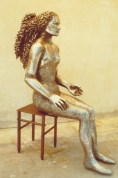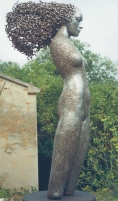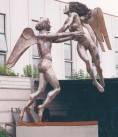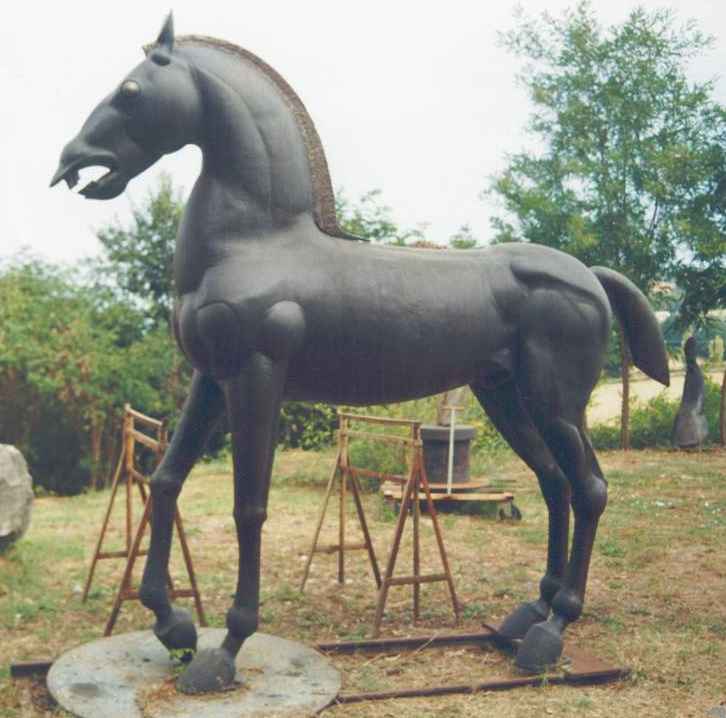
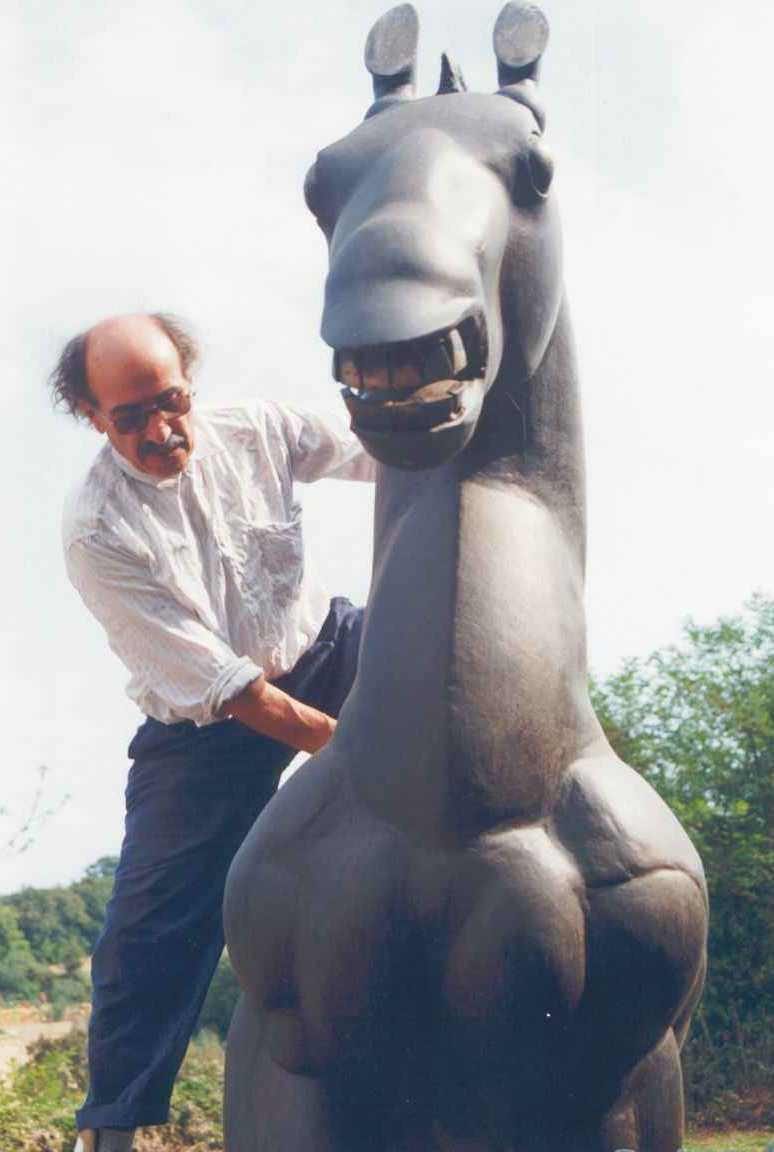
"Il
cavallo di Orlando"
iron
cm 264 x cm 289 x cm 119
Iron and inox steel sculptures are the fruit of a work done by the master at hot temperatures by the mallet, and at cold temperatures by coinage. So worked, the single elements constituting them, are then assembled by electric welding. The stylistic and expressive choice of Terenzio Pedini have led him to exclude completely from his works the fusion technique by lost wax.
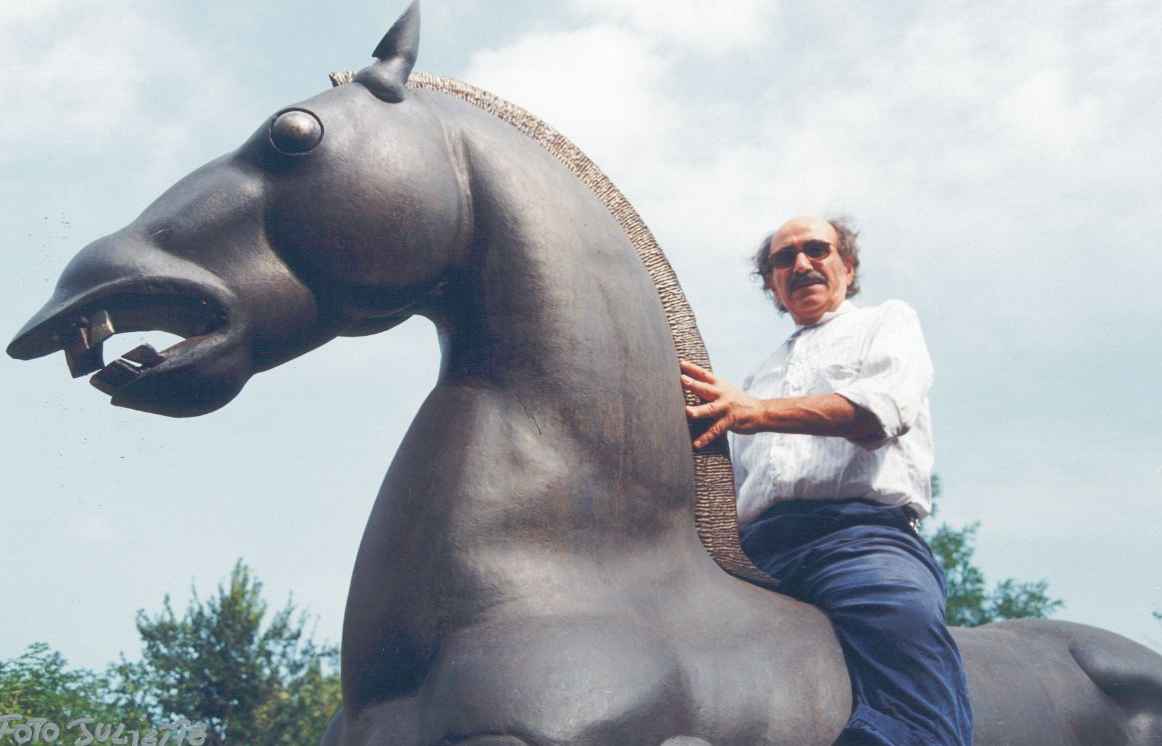
|
Critical review |
|
|
It has always been rare to find an artist able to surprise and to
give us back joy and anxieties, wonders and amazements through his/her
quiet and strong artcraft. In these days of planned irreverences
and constricted transgressions Terenzio Pedini's rough powerful
sculptures demonstrate a creative state of grace almost unconceivable.
But, as we cannot deny the happy results reached by the artists
while forging his images of love and nightmare, we cannot but take
into consideration a survived strenght of the art and of the single
person who believes and creates in solitude as if he/she were praying.
I cannot - thinking of Pedini and his secluded bottega marchigiana
(shop in the Italian region of Le Marche), where he has been beating
iron for years creating simulacres of obstinate dreams and maybe
even ghosts of is allucinations - I cannot get free from the idea
that even serenity could belong to this period and that sometimes
the joy of doing could overcome the conscience of pain and passion,
vivid in this artist. It is certainly true that Pedini does not
belong to the cursed artists by vocational attitude, but even serenity
has a right to its nightmares. So there is no lack of monsters in
the angelic bestiary of this master of iron who repeat, in the shapes
of a confident modernity, the path followed by tradition in classic
Italian sculpture and the primitive one. It will be easy to observe
in Pedini's work the arcaic memory of Wiligelmo and of the Metope's
master, of Nicola and Giovanni Pisano. The darkened gothic stops
the image of the archibishop Turpino and it melt in the powerful
and vaguely byzantine elegance of Orlando's horse. Elks and Elphants,
the shooting Greyhound and the types of a singular zoomorphous range
crowd together, grinning and gentle as in one of Rabelais' pages,
and they testify a culture which is aulic because it keeps inside
itself the vigour of vulgarity and the concrete sense of the sublimate
being in the metaphors of the monumentum. It is quickly understood
that Pedini's immagination pushes and forces the limits of the quiet
well-doing revealing himself also in the overbearing handycraft
colouring the human sublime of the martyr-Christ. It is the miracle
of the craft, of the aestethic dignity presented without negotiations
as a moral dignity. We could describe Pedini, with the whole charge
of denunciation of his works, as an artist of consecrations, a sincere
moralist. That is where he found enough heart and discretion to
work joyfully like an anchoret, keeping himself at the borders of,
but not outside, the circuits of beauty and ugliness, the good and
the bad of art. |
Gallery Click on the
image
"Aquila"
"Alce"
"Ariete"
"Bucranio
con corno"
"Donna seduta"
"La bagnante"
"Uccello"
"Angeli
del nostro tempo" |
|
I
like to remember the day when Terenzio Pedini unloaded his sculptures
from a van near the front door of the editorial office of a periodical
I was directing at that time. We had agreed by the phone. Pedini
had asked to meet me: "I would like to show you some works of mine"
he said. And I thought he intended to bring me photos and slides
of his works, maybe together with a pair of his sculptures of small
dimensions. On the contrary, in a few minutes, the small garden
right outside my office door got transformed in a small plastic
museum "en plain air". Pedini had unloaded about ten sculptures
of big size and very heavy. And he stood there, sweating and almost
trembling, waiting from me to judge his work. I met Terenzio Pedini
and his work in this way. A sculptor who works iron as we used to
do very long ago, with an acknoledged skill, using his arms strength
and the mallet/hammer and transforming almost alchemically the "vile"
metal into shapes of exceptional expressive strength. It seems very
important to me to underline his skill in joining together, almost
paradoxically, a very strong sense of synthesis and a vibrating
and often lyric taste for analysis. I mean that Pedini's form is
almost always strongly condensed, sometimes almost congealed in
its own "pondus" (see, for example, a very essential figure of a
bishop), while some other times his form is analytically investigated
in the anathomical detail (a head, a torso, a limb) or in the decorative
detail (the minute graphics of elk horns, the hair and the swarming
skin of a seated woman). And these two aspect (summerizing and concise,
the first, fragmented and diffused the second), by definition dicothomical,
in Pedini's artistic expression, in his magic attitude to create
visual metaphors, cohabit as if complementary parts of a perfect
osmothic union…Pedini works in an extremely dinamic way into the
physical space, as his sculptures are not pure contents put inside
a pure container; on the contrary his plastic works are linked to
the space, interact with it creating a lively area uniting and melting
to the surrounding space. The space comes to be the page where to
write the words of a short story, or the natural setting for an
event to take place. That's why Terenzio Pedini has to be considered
a narrator and his sculpture should take the characteristics of
a visualized short where human figures, things, animals, and space
live together, in a perfect symbiosis, as on the stage of a theatre
or even on the stage of life. |
|
|
"….inside
the bodies of these figures we almost feel the push of a vital lymph,
a quiver running under our skin, lingerings over sensibility expressing
themselves in higher notes and giving to the whole sculpture a peculiar
exaltation, a strong feeling for life, wide and unprejudiced."
(Bruno Ceci) |
|




